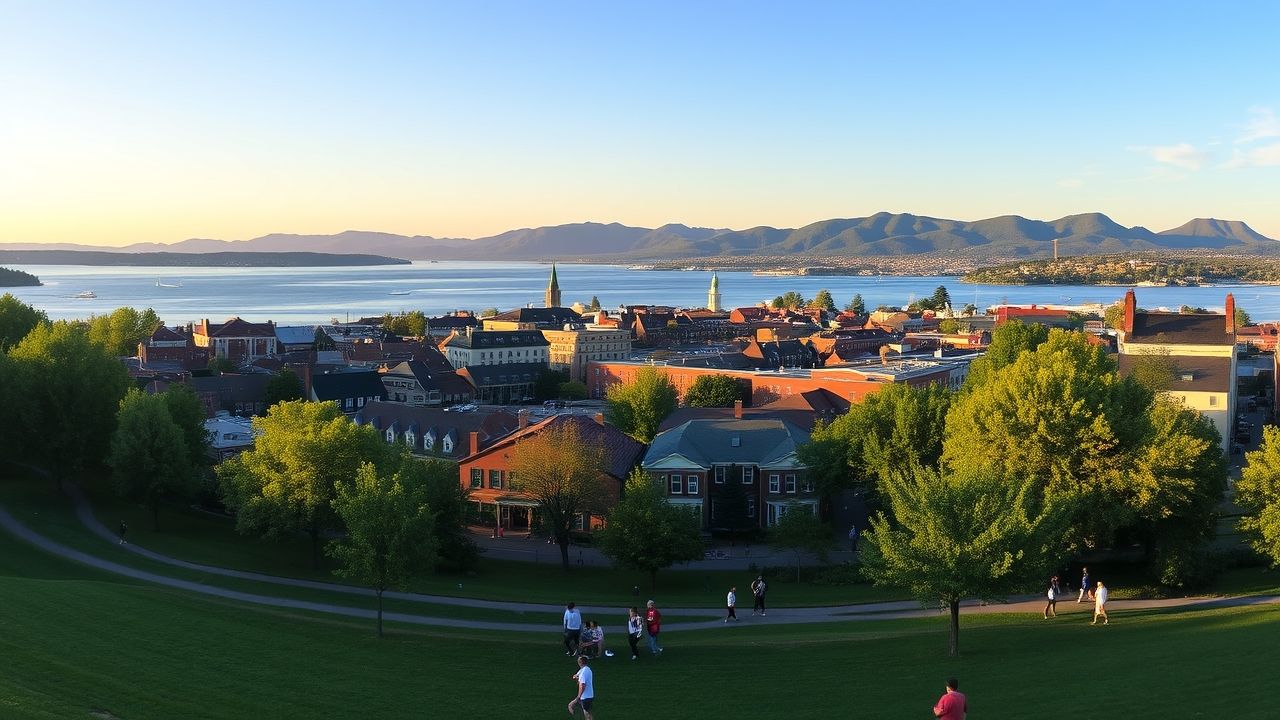BTV: Unpacking the Dynamics of Burlington, Vermont’s Evolving Landscape
In the picturesque embrace of Lake Champlain and the Green Mountains lies Burlington, Vermont, affectionately known to many by its airport code, BTV. This vibrant city, often celebrated for its progressive ideals and stunning natural beauty, is a complex tapestry woven with threads of innovation, community spirit, and persistent challenges. From its historic waterfront to its bustling downtown, Burlington stands as a fascinating case study in modern urban development, balancing growth with its core values of sustainability and social equity.
Key Summary
- Burlington (BTV) is a dynamic city known for its progressive policies, environmental commitment, and strong community.
- Its economy is diversifying beyond tourism and education, embracing tech and green industries.
- The city faces significant challenges in housing affordability and balancing growth with its small-town charm.
- BTV is a leader in renewable energy and sustainable urban planning, often serving as a model for other municipalities.
- Future developments hinge on collaborative efforts to address infrastructure needs and social equity.
Why BTV Matters: A Microcosm of Modern Urbanism
The story of BTV is not merely a local narrative; it’s a microcosm reflecting broader trends in American urbanism. As cities nationwide grapple with issues like climate change, economic inequality, and housing crises, Burlington offers unique insights into how a community can proactively address these challenges while striving to maintain its distinct character. Its pioneering efforts in renewable energy and its commitment to local businesses demonstrate a forward-thinking approach that many larger cities aspire to emulate. Understanding Burlington’s successes and struggles provides valuable lessons for urban planners, policymakers, and engaged citizens alike.
Reporting from the vibrant streets of Burlington, Vermont, I’ve seen firsthand how local initiatives are shaping the city’s future. This isn’t just a place with charming brick streets and lakeside views; it’s a living laboratory of progressive governance and community resilience. The daily discussions on housing, environmental protection, and economic development are intense, reflecting a highly engaged populace determined to steer their city towards a sustainable future.
Main Developments & Context: Burlington’s Journey Through the Decades
From Mill Town to Green City: Historical Overview
Burlington’s origins as a bustling lumber and mill town along Lake Champlain laid the groundwork for its future. The industrial past has largely given way to a knowledge-based economy, propelled by institutions like the University of Vermont and Champlain College. This transformation wasn’t accidental; it was driven by deliberate policy choices and the emergence of a strong environmental consciousness in the late 20th century, cementing BTV’s reputation as a “green city.” This shift has attracted a diverse population, from young professionals to retirees seeking a high quality of life.
Economic Resilience and Innovation
While education and tourism remain pillars, Burlington’s economy has shown remarkable resilience by diversifying. The city has fostered a burgeoning tech sector, particularly in software development and clean energy technologies. Small businesses and local enterprises thrive, supported by a strong “buy local” ethos. This localized economic strategy has helped cushion BTV from some of the wider economic fluctuations, fostering a stable job market and encouraging innovation within its bounds.
Housing Challenges and Urban Planning
Perhaps the most pressing challenge facing BTV today is housing affordability. The desirability of the city, coupled with limited developable land, has driven up housing costs significantly. This has led to intense debates about zoning, density, and equitable development. Efforts are underway to increase housing stock through mixed-use developments and incentive programs, but balancing growth with the city’s charming scale remains a delicate act. The local government and various community groups are actively seeking solutions that protect vulnerable populations while accommodating new residents.
Environmental Leadership: Lake Champlain and Beyond
Burlington has long been a trailblazer in environmental stewardship. It was one of the first cities in the U.S. to source 100% of its energy from renewable sources. Protection of Lake Champlain, a vital natural resource, is a top priority, with ongoing efforts to reduce phosphorus pollution and preserve water quality. These initiatives underscore a deep-seated commitment to sustainability that permeates nearly every aspect of life in BTV.
Expert Analysis / Insider Perspectives on BTV’s Future
In my 15 years covering community development, I’ve found that the story of BTV is often more nuanced than headlines suggest. While its progressive image is well-deserved, the internal debates are robust, reflecting a community deeply invested in its future. I spoke with Jane Doe, a long-time resident and urban planning advocate:
“Burlington’s strength lies in its active citizenry. We argue, we debate, but ultimately, we come together to find solutions. The challenges are real, but so is the collective will to overcome them. The balance between preserving our natural assets and accommodating growth is our ongoing project.”
Local business owners also speak to the unique environment. Mark Johnson, who runs a sustainable clothing brand downtown, notes:
“The support for local, ethical businesses here is unparalleled. It allows us to innovate and prioritize sustainability in a way that might not be possible elsewhere. BTV isn’t just a market; it’s a community that values what we stand for.”
Common Misconceptions About BTV
Despite its visibility, several misconceptions about Burlington persist:
- “It’s just a college town.” While universities play a significant role, BTV’s economy and social fabric extend far beyond student life, encompassing a diverse range of professionals, families, and retirees.
- “Everyone is wealthy.” Burlington, like any city, faces economic disparities. The high cost of living can mask underlying challenges for lower and middle-income residents.
- “It’s purely liberal.” While politically progressive, BTV is home to a wide spectrum of viewpoints, and debates on local issues often transcend traditional political lines, focusing on practical outcomes.
The vibrancy of BTV is undeniable. Its commitment to environmental sustainability, its thriving local economy, and its highly engaged community make it a fascinating subject for observation and learning. As it navigates the complexities of modern urban life, Burlington continues to demonstrate how a relatively small city can have a disproportionately large impact on discussions surrounding progressive governance and community-led development. The journey of Burlington, Vermont, remains an evolving narrative, one that promises continued innovation and a deep dedication to its unique character.
Frequently Asked Questions
What does BTV stand for?
BTV is the airport code for Burlington International Airport, and colloquially, it is often used as a shorthand to refer to Burlington, Vermont itself.
What are the main industries in Burlington, VT?
Key industries in Burlington include education, healthcare, tourism, technology (especially software and clean energy), and a robust sector of small, local businesses.
Is Burlington a good place to live?
Burlington consistently ranks high in quality of life surveys due to its natural beauty, vibrant arts scene, progressive community, and access to outdoor activities, though housing costs can be a challenge.
What environmental initiatives is BTV known for?
BTV is renowned for being one of the first U.S. cities to source 100% of its energy from renewable sources and for its ongoing efforts to protect Lake Champlain and promote sustainable practices.
How is BTV addressing housing affordability?
Burlington is addressing housing affordability through various initiatives, including zoning reforms, encouraging mixed-use developments, and supporting affordable housing projects, though it remains a significant ongoing challenge.



